
The Trail of Tears:
A Journey of Suffering and Survival Through Winchester TN
The Trail of Tears -- I've seen signs for it throughout Tennessee. Its clearly significant, but what is it?
After a bit of research, the Trail of Tears impacted tens of thousands of people. And a trail went through downtown Winchester TN in the mid-1800's. In fact, each year the Franklin County Historical Society runs a commemorative walk of the trail of tears through Winchester. In 2023, the Walk was on Oct 28.
The Trail of Tears refers to the forced relocation of Native American nations from their ancestral lands in the Southeastern United States to designated areas west of the Mississippi River, known as Indian Territory. This mass movement, occurring in the 1830s, led to the suffering and deaths of thousands of Native Americans.
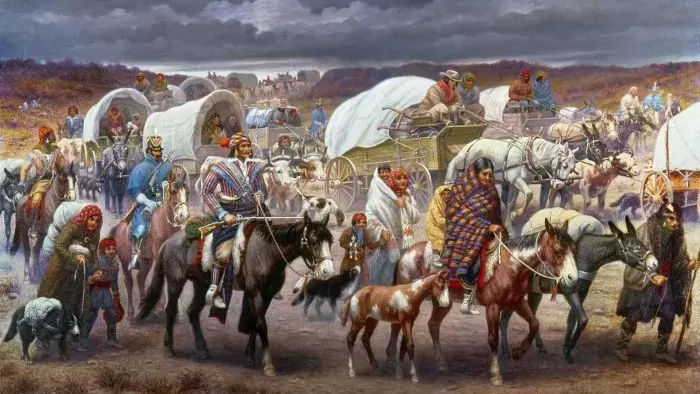 Trail of Tears Painting
Trail of Tears Painting
artist: Robert Lindneux
Trail of Tears: Background and Legal Foundation
The U.S. government's policy of Indian removal, driven by the desire to expand territory for agriculture and spurred by the discovery of gold in Georgia in 1828, culminated in the Indian Removal Act of 1830. Signed into law by President Andrew Jackson, this act authorized negotiations for the (somewhat forced) relocation of southern Native American tribes to new land in the mid-west in exchange for their ancestral homelands.
Trail of Tears: Affected Tribes
The US Government identified five Native American Tribes as the "Five Civilized Tribes" who bore the brunt of this policy – Cherokee, Muscogee (Creek), Seminole, Chickasaw, and Choctaw.
- The Cherokee, losing over 4,000 of their 15,000 members during the journey, are often most associated with the Trail of Tears.
- The Muscogee (Creek), with approximately 20,000 members removed, and the Seminole, of whom about 3,000 were relocated, faced similar fates.
- The Chickasaw and Choctaw, with 4,000-5,000 and 12,000-15,000 members removed respectively, also endured the harsh realities of relocation.
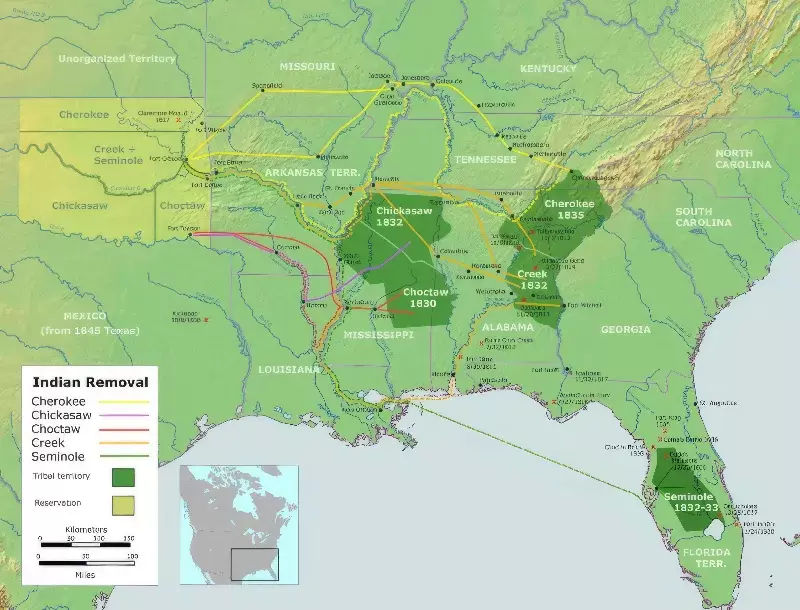 Locations of Native Americans before the Trail of Tears
Locations of Native Americans before the Trail of Tears
The Trail of Tears: The Process of Removal
The removal began with the forcible rounding up of Native Americans from their homes into temporary holding camps. This process, marked by distress and hardship, involved states like Georgia, Alabama, North Carolina, Tennessee, and South Carolina. Chattanooga, near the Tennessee-Georgia border, became a pivotal site, serving as a holding area before the westward journey. The conditions in these camps were dire, characterized by overcrowding, inadequate resources, and poor living conditions.
The trail through Winchester TN began in Chattanooga for approximately 650 people.
The Trail of Tears: Journey Westward
From these camps, the tribes embarked on their arduous journey to present-day Oklahoma. Traveling by foot, horse, wagon, and boat, they faced extreme hardship, disease, and inadequate supplies. The winter weather further exacerbated their suffering, leading to high mortality rates.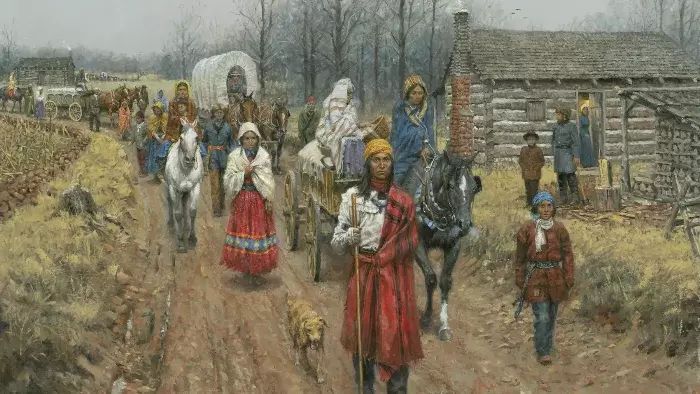 Trail of Tears
Trail of Tears
artist: Andy Thomas
The Trail of Tears Bell Route: A Specific Path of the Cherokee
A notable segment of this journey is the Bell Route, led by John Adair Bell, a Cherokee and signing member of the treaty and John Ross. Starting from Fort Cass which was an internment camp for native Cherokee in just outside of Chattanooga on October 11, 1838, Bell's detachment, comprising about 650-700 Cherokee, took a more direct route through southern Tennessee via Memphis. This detachment, distinct from those under Chief John Ross, traveled through Chattanooga, crossed the Tennessee River multiple times, and passed through Winchester TN on October 27, 1838, moving at a pace of approximately 10-12 miles a day.
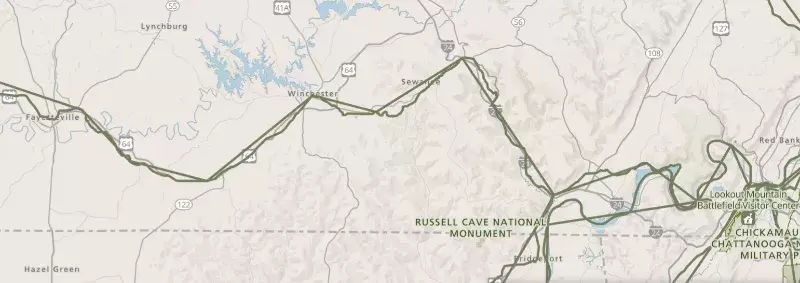 Trail of Tears trail going through Franklin County TN including Winchester TN
Trail of Tears trail going through Franklin County TN including Winchester TN
The route continued through the southern tier of counties along the Alabama border, many of which later became part of US 64. The detachment passed through towns like Winchester TN, Fayetteville, Pulaski, and Lawrenceburg, following early 19th-century roads. In fact, the trail actually goes right through the Winchester TN Square. They walked by both the Bolling Fork and Elk Rivers which is now the Tims Ford Lake.
 Plaque on Winchester TN business on the Winchester TN Square
Plaque on Winchester TN business on the Winchester TN Square
After crossing the Mississippi River into Arkansas, they avoided encounters with anti-treaty Cherokee detachments and disbanded at the Vineyard Post Office (now Evansville) on January 7, 1839.
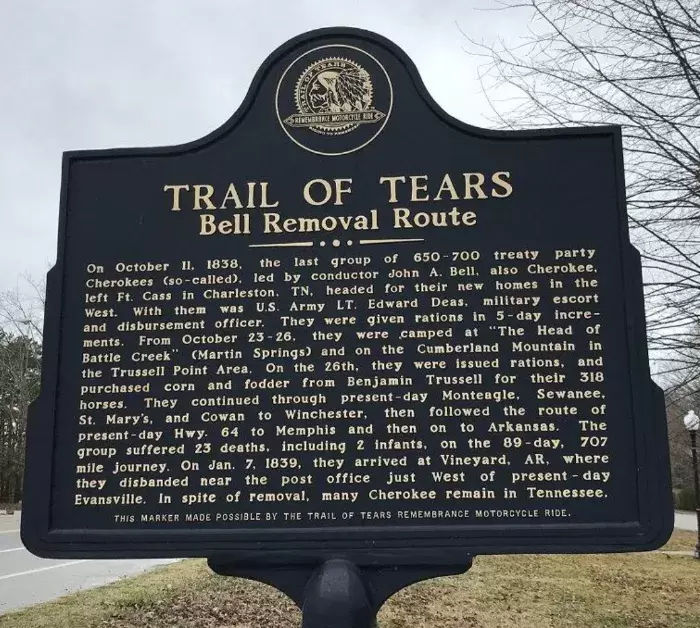 Trail of Tears Plaque outside of Evansville AR
Trail of Tears Plaque outside of Evansville AR
The Franklin County TN Historical Society, along with the Tennessee Trail of Tears Association and National Park Service, installed signs to document the route of the Trail of Tears through Franklin County TN including Winchester TN.
The signs are in Monteagle and Sewanee along the Mountain Goat Trail, to Sherwood Road, the Templeton Library where the trail descends the mountain. The signs start again by the bottom of the mountain through Cowan and Winchester, going around the Square and following Highway 64 before ending on the old David Crockett Highway in Lincoln County.
Trail of Tears: Impact and Legacy
The Trail of Tears resulted in a significant loss of life and had a profound cultural and societal impact on the Native American tribes. It represents a dark period in U.S. history, highlighting the consequences of expansionist policies and disregard for indigenous rights.
The legacy of the Trail of Tears is preserved through historical sites, trails, and educational programs. The Trail of Tears National Historic Trail, managed by the National Park Service, commemorates the forced removal of the Cherokee and the paths they traveled, serving as a reminder of this tragic episode in American history and its lasting impact on Native American communities.
 Trail of Tears Art
Trail of Tears Art
artist Max Stanley
The Trail of Tears, with its harrowing journey and profound impact, remains a poignant reminder of a tragic time in American history. The Bell Route, passing through places like Winchester TN, offers a specific lens to view this larger narrative, underscoring the resilience and suffering of the Native American tribes during this forced relocation. Remembering and learning from this history is crucial in honoring the affected communities and fostering a deeper understanding of this significant event.
See more historical articles in the Tims Ford Lake Area
TimsFord411.com -
The Ultimate Guide To The Tims Ford Lake Area
Business Listings || Weather / Weather Radar || Things to Do || Area Articles || Community Calendar
Winchester TN || Tullahoma TN || Lynchburg TN || Estill Springs TN || Decherd TN
TimsFord411.com is the ultimate guide to all things by the Tims Ford Lake Area. Find businesses, things to do, historical articles, local weather and weather radar, jobs, the lake level, a community calendar, and more. All in one single place. Business Owner? Make sure to claim your profile





Leave Comment Below